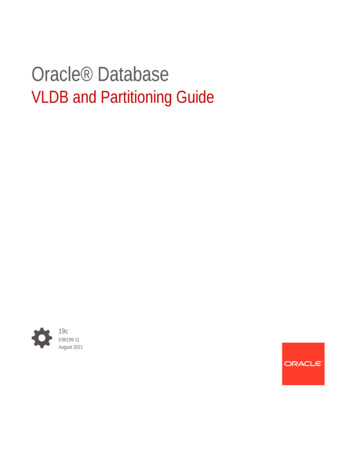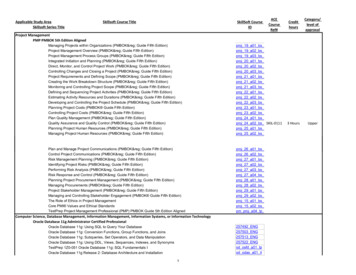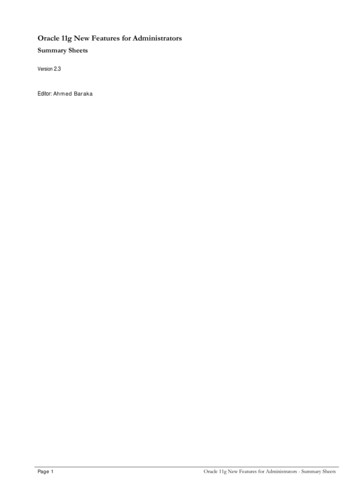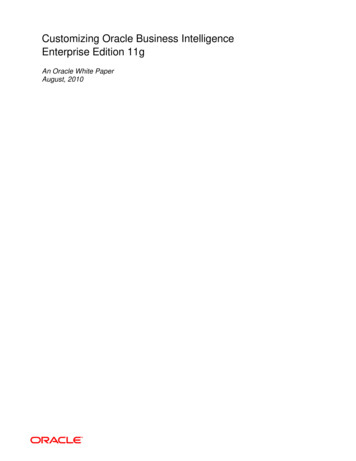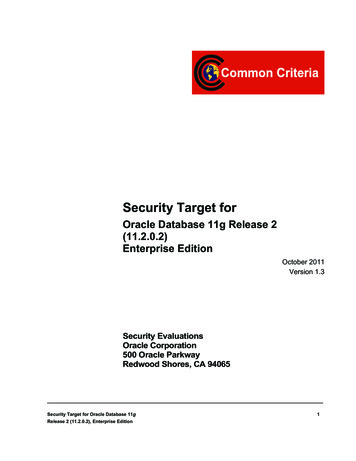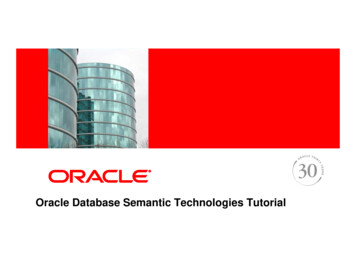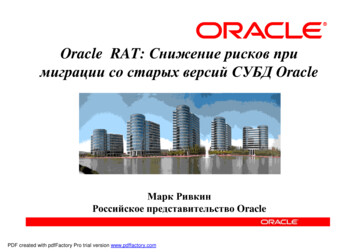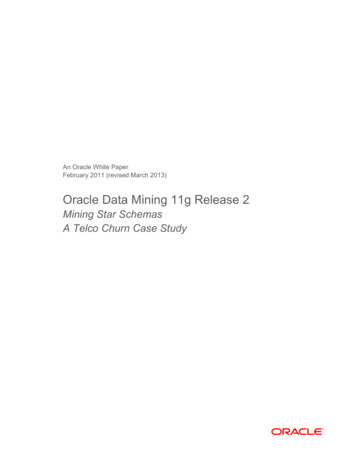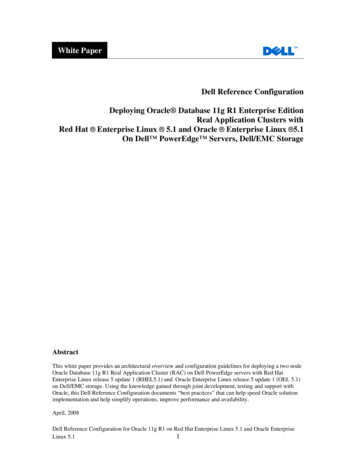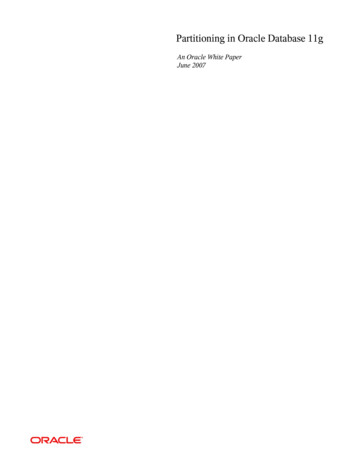
Transcription
Partitioning in Oracle Database 11gAn Oracle White PaperJune 2007
NOTE:The following is intended to outline our general product direction. It is intendedfor information purposes only, and may not be incorporated into any contract. It isnot a commitment to deliver any material, code, or functionality, and should notbe relied upon in making purchasing decisions. The development, release, andtiming of any features or functionality described for Oracle’s products remains atthe sole discretion of Oracle.Partitioning in Oracle Database 11gPage 2
Partitioning in Oracle Database 11gNote:.2Partitioning – Concepts.5Introduction.5Benefits of Partitioning .5Basics of Partitioning.5Partitioning for Manageability .7Partitioning for Performance .7Partitioning for Availability .8Partitioning – Modeling for your Business.9Basic Partitioning Strategies.9Partitioning Extensions.10Partition Advisor.11Partitioning Strategies and Extensions at a Glance.12Information Lifecycle Management with Partitioning.12Conclusion.13Partitioning in Oracle Database 11gPage 3
Partitioning in Oracle Database 11gPARTITIONING – CONCEPTSINTRODUCTIONOracle Partitioning, first introduced in Oracle 8.0 in 1997, is one of the mostimportant and successful functionalities of the Oracle database, improving theperformance, manageability, and availability for tens of thousands of applications.Oracle Database 11g introduces the 8th generation of partitioning which continuesto offer ground-breaking new and enhanced functionality; new partitioningtechniques enable customers to model even more business scenarios while acomplete new framework of partition advice and automation enables the usage ofOracle Partitioning for everybody. Oracle Database 11g is considered the biggestnew release for partitioning since its first introduction, continuing to protect ourcustomers' investment in partitioning for a decade.BENEFITS OF PARTITIONINGPartitioning can provide tremendous benefits to a wide variety of applications byimproving manageability, performance, and availability. It is not unusual forpartitioning to improve the performance of certain queries or maintenanceoperations by an order of magnitude. Moreover, partitioning can greatly reducethe total cost of data ownership, using a “tiered archiving” approach of keepingolder relevant information still online on low cost storage devices. OraclePartitioning enables an efficient and simple, yet very powerful approach whenconsidering Information Lifecycle Management for large environments.Partitioning also enables database designers and administrators to tackle some ofthe toughest problems posed by cutting-edge applications. Partitioning is a keytool for building multi-terabyte systems or systems with extremely highavailability requirements.Basics of PartitioningPartitioning allows a table, index or index-organized table to be subdivided intosmaller pieces. Each piece of the database object is called a partition. Eachpartition has its own name, and may optionally have its own storagecharacteristics. From the perspective of a database administrator, a partitionedobject has multiple pieces that can be managed either collectively or individually.This gives the administrator considerable flexibility in managing partitionedPartitioning in Oracle Database 11gPage 4
object. However, from the perspective of the application, a partitioned table isidentical to a non-partitioned table; no modifications are necessary whenaccessing a partitioned table using SQL DML commands.Figure 1: Application and DBA perspective of a partitioned tableDatabase objects - tables, indexes, and index-organized tables - are partitionedusing a 'partitioning key', a set of columns which determine in which partition agiven row will reside. For example the sales table shown in figure 1 is rangepartitioned on sales date, using a monthly partitioning strategy; the table appearsto any application as a single, 'normal' table. However, the DBA can manage andstore each monthly partition individually, potentially using different storage tiers,applying table compression to the older data, or store complete ranges of olderdata in read only tablespaces.Irrespective of the chosen index partitioning strategy, an index is either coupled oruncoupled with the underlying partitioning strategy of the underlying table. Theappropriate index partitioning strategy is chosen based on the businessrequirements, making partitioning well suited to support any kind of application.Oracle Database 11g differentiates between three types of partitioned indexes. Local Indexes: A local index is an index on a partitioned table that iscoupled with the underlying partitioned table, 'inheriting' the partitioningstrategy from the table. Consequently, each partition of a local indexcorresponds to one - and only one - partition of the underlying table. Thecoupling enables optimized partition maintenance; for example, when atable partition is dropped, Oracle simply has to drop the correspondingindex partition as well. No costly index maintenance is required. Localindexes are most common in data warehousing environments. Global Partitioned Indexes: A global partitioned index is an index on apartitioned or non-partitioned table that is partitioned using a differentpartitioning-key or partitioning strategy than the table. Global-partitionedindexes can be partitioned using range or hash partitioning and areuncoupled from the underlying table. For example, a table could be rangepartitioned by month and have twelve partitions, while an index on thattable could be range-partitioned using a different partitioning key and havePartitioning in Oracle Database 11gPage 5
a different number of partitions. Global partitioned indexes are morecommon for OLTP than for data warehousing environments.Global Non-Partitioned Indexes: A global non-partitioned index isessentially identical to an index on a non-partitioned table. The indexstructure is not partitioned and uncoupled from the underlying table. In datawarehousing environments, the most common usage of global nonpartitioned indexes is to enforce primary key constraints. OLTPenvironments on the other hand mostly rely on global non-partitionedindexes. Oracle additionally provides a comprehensive set of SQL commands formanaging partitioning tables. These include commandsfor adding new partitions,dropping, splitting, moving, merging, truncating, and optionally compressingpartitions.Partitioning for ManageabilityOracle Partitioning allows tables and indexes to be partitioned into smaller, moremanageable units, providing database administrators with the ability to pursue a"divide and conquer" approach to data management.With partitioning, maintenance operations can be focused on particular portions oftables. For example, a database administrator could compress a single partitioncontaining say the data for the year 2006 of a table, rather than compressing theentire table. For maintenance operations across an entire database object, it ispossible to perform these operations on a per-partition basis, thus dividing themaintenance process into more manageable chunks.A typical usage of partitioning for manageability is to support a 'rolling window'load process in a data warehouse. Suppose that a DBA loads new data into a tableon weekly basis. That table could be range-partitioned so that each partitioncontains one week of data. The load process is simply the addition of a newpartition. Adding a single partition is much more efficient than modifying theentire table, since the DBA does not need to modify any other partitions.Another advantage of using partitioning is when it is time to remove data, anentire partition can be dropped which is very efficient and fast, compared todeleting each row individually.Partitioning for PerformanceBy limiting the amount of data to be examined or operated on, partitioningprovides a number of performance benefits. These features include: Partitioning Pruning: Partitioning pruning (a.k.a. Partition elimination)is the simplest and also the most substantial means to improveperformance using partitioning. Partition pruning can often improvequery performance by several orders of magnitude. For example, supposean application contains an ORDERS table containing an historical recordPartitioning in Oracle Database 11gPage 6
of orders, and that this table has been partitioned by week. A queryrequesting orders for a single week would only access a single partitionof the ORDERS table. If the table had 2 years of historical data, thisquery would access one partition instead of 104 partitions. This querycould potentially execute 100x faster simply because of partition pruning.Partition pruning works with all of Oracle's other performance features.Oracle will utilize partition pruning in conjunction with any indexingtechnique, join technique, or parallel access method. Partition-wise Joins: Partitioning can also improve the performance ofmulti-table joins, by using a technique known as partition-wise joins.Partition-wise joins can be applied when two tables are being joinedtogether, and at least one of these tables is partitioned on the join key.Partition-wise joins break a large join into smaller joins of 'identical' datasets for the joined tables. 'Identical' here is defined as covering exactlythe same set of partitioning key values on both sides of the join, thusensuring that only a join of these 'identical' data sets will produce a resultand that other data sets do not have to be considered. Oracle is usingeither the fact of already (physical) equi-partitioned tables for the join oris transparently redistributing ( “repartitioning”) one table at runtime tocreate equi-partitioned data sets matching the partitioning of the othertable, completing the overall join in less time. This offers significantperformance benefits both for serial and parallel execution.Partitioning for AvailabilityPartitioned database objects provide partition independence. This characteristic ofpartition independence can be an important part of a high-availability strategy. Forexample, if one partition of a partitioned table is unavailable, all of the otherpartitions of the table remain online and available. The application can continue toexecute queries and transactions against this partitioned table, and these databaseoperations will run successfully if they do not need to access the unavailablepartition.The database administrator can specify that each partition be stored in a separatetablespace; this would allow the administrator to do backup and recoveryoperations on each individual partition, independent of the other partitions in thetable. Therefore in the event of a disaster, the database could be recovered withjust the partitions comprising of the active data, and then the inactive data in theother partitions could be recovered at a convenient time. Thus decreasing thesystem down-time.Moreover, partitioning can reduce scheduled downtime. The performance gainsprovided by partitioning may enable database administrators to completemaintenance operations on large database objects in relatively small batchwindows.Partitioning in Oracle Database 11gPage 7
PARTITIONING – MODELING FOR YOUR BUSINESSOracle Database 11g provides the most comprehensive set of partitioningstrategies, allowing a customer to optimally align the data subdivision with theactual business requirements. All available partitioning strategies rely onfundamental data distribution methods that can be used for either single (onelevel) or composite partitioned tables. Furthermore, Oracle provides a variety ofpartitioning extensions, increasing the flexibility for the partitioning keyselection, providing automated partition creation as-needed, and advising onpartitioning strategies for non-partitioned objects.Basic Partitioning StrategiesOracle Partitioning offers three fundamental data distributionmethods that controlhow the data is actually going to placed into the various individual partitions,namely: Range: The data is distributed based on a range of values of thepartitioning key (for a date column as the partitioning key, the 'January2007' partition contains rows with the partitioning-key values between'01-JAN-2007' and '31-JAN-2007'). The data distribution is a continuumwithout any holes and the lower boundary of a range is automaticallydefined by the upper boundary of the preceding range. List: The data distribution is defined by a list of values of the partitioningkey (for a region column as the partitioning key, the 'North America'partition may contain values 'Canada', 'USA', and 'Mexico'). A special'DEFAULT' partition can be defined to catch all values for a partition keythat are not explicitly defined by any of the lists. Hash: A hash algorithm is applied to the partitioning key to determinethe partition for a given row. Unlike the other two data distributionmethods, hash does not provide any logical mapping between the dataand any partition.Using the above-mentioned data distribution methods, a table can be partitionedeither as single or composite partitioned table: Single (one-level) Partitioning:A table is defined by specifying one ofthe data distribution methodologies, using one or more columns as thepartitioning key. For example consider a table with a number column asthe partitioning key and two partitions 'less than five hundred' and'less than thousand', the 'less than thousand' partition contains rowswhere the following condition is true: 500 Partitioning key 1000.You can specify Range, List, and Hash partitioned tables. Composite Partitioning: A combination of two data distributionmethods are used to define a composite partitioned table. First, the tableis partitioned by data distribution method one and then each partition isPartitioning in Oracle Database 11gPage 8
further subdivided into subpartitions using a second data distributionmethod. All sub-partitions for a given partition together represent alogical subset of the data. For example, a range-hash compositepartitioned table is first range-partitioned, and then each individual rangepartition is further sub-partitioned using the hash partitioning technique.Available composite partitioning techniques are range-hash, range-list,range-range, list-range, list-list, and list-hash. Index-organized tables (IOTs) can be partitioned using range, hash, andlist partitioning. Composite partitioning is not supported for IOTs.Partitioning ExtensionsIn addition to the basic partitioning strategies, Oracle provides partitioningextensions. The extensions in Oracle Database 11g mainly focus on twoobjectives:(a) Enhance the manageability of a partitioned table significantly.(b) Extend the flexibility in defining a partitioning key.The extensions are namely:Interval Partitioning: A new partitioning strategy in Oracle Database 11g,Interval partitioning extends the capabilities of the range method to define equipartitioned ranges using an interval definition. Rather than specifying individualranges explicitly, Oracle will create any partition automatically as-neededwhenever data for a partition is inserted for the very first time. Intervalpartitioning greatly improves the manageability of a partitioned table. Forexample, an interval partitioned table could be defined so that Oracle creates anew partition for every month in a calendar year; a partition is then automaticallycreated for 'September 2007' as soon as the first record for this month is insertedinto the database.The available techniques for an interval partitioned table are Interval, IntervalList, Interval-Hash, and Interval-Range.REF Partitioning: Oracle Database 11g allows to partition a table by leveragingan existing parent-child relationship. The partitioning strategy of the parent tableis inherited to its child table without the necessity to store the parent's partitioningkey columns in the child table. Without REF Partitioning you have to duplicate allpartitioning key columns from the parent table to the child table if you want totake advantage from the same partitioning strategy; REF Partitioning on the otherhand allows you to naturally partition tables according to the logical data modelwithout requiring to store the partitioning key columns, thus reducing the manualoverhead for denormalization and saving space. REF Partitioning alsotransparently inherits all partition maintenance operations that change the logicalshape of a table from the parent table to the child table. Furthermore, REFPartitioning automatically enables partition-wise joins for the equi-partitions ofPartitioning in Oracle Database 11gPage 9
the parent and child table, improving the performance for this operation. Forexample, a parent table ORDERS is Range partitioned on the ORDER DATEcolumn; its child table ORDER ITEMS does not contain the ORDER DATEcolumn but can be partitioned by reference to the ORDERS table. If the ORDERStable is partitioned by month, all order items for orders in 'Jan-2007' will then bestored in a single partition in the ORDER ITEMS table, equi-partitioned to theparent table ORDERS. If a partition 'Feb-2007' is added to the ORDERS tableOracle will transparently add the equivalent partition to the ORDER ITEMS table.All basic partitioning strategies are available for REF Partitioning.Virtual column-based Partitioning: In previous versions of Oracle, a table couldonly be partitioned if the partitioning key physically existed in the table. Virtualcolumns, a new functionality in Oracle Database 11g, removes that restrictionand allows the partitioning key to be defined by an expression, using one or moreexisting columns of a table, and storing the expression as metadata only.Partitioning has been enhanced to allow a partitioning strategy being defined onvirtual columns, thus enabling a more comprehensive match of the businessrequirements. It is not uncommon to see columns being overloaded withinformation; for example a 10 digit account ID can include an account branchinformation as the leading three digits. With the extension of virtual columnbased Partitioning, the ACCOUNTS table containing a column ACCOUNT IDcan be extended with a virtual (derived) column ACCOUNT BRANCH that isderived from the first three digits of the ACCOUNT ID column which becomesthe partitioning key for this table.Virtual column-based Partitioning is supported with all basic partitioningstrategies.Partition AdvisorThe SQL Access Advisor in Oracle Database 11g has been enhanced to generatepartitioning recommendations, in addition to the ones it already provides forindexes, materialized views and materialized view logs. Recommendationsgenerated by the SQL Access Advisor – either for Partitioning only or holistically- will show the anticipated performance gains that will result if they areimplemented. The generated script can either be implemented manually orsubmitted onto a queue within Oracle Enterprise Manager.With the extension of partitioning advice, customers not only can getrecommendation specifically for partitioning but also a more comprehensiveholistic recommendation of SQL Access Advisor, improving the collectiveperformance of SQL statements overall.The Partition Advisor, integrated into the SQL Access Advisor, is part of Oracle'sTuning Pack, an extra licensable option. It can be used from within EnterpriseManager or via a command line interface.Partitioning in Oracle Database 11gPage 10
Partitioning Strategies and Extensions at a GlanceThe following table gives a conceptual overviewof all available basic partitioningstrategies in Oracle Database 11g:Partitioning StrategyData DistributionRange PartitioningBased on consecutive ranges ofvalues.Sample Business CaseList PartitioningBased on unordered lists ofvalues. Orders table list partitionedby countryHash PartitioningBased on a hash algorithm. Orders table hash partitionedby customer idComposite Partitioning Range-Range Range-List Range-Hash List-List List-Range List-HashBased on a combination of twoof the above-mentioned basictechniques of Range, List,Hash, and Interval Partitioning Orders table is rangepartitioned by order dateand sub-partitioned by hashon customer id Orders table is rangepartitioned by order dateand sub-partitioned by rangeon shipment date Orders table rangepartitioned by order dateIn addition to the available partitioning strategies, Oracle Database 11g providesthe following partitioning extensions:Partitioning ExtensionPartitioning KeySample Business CaseInterval Partitioning Interval Interval-Range Interval-List Interval-HashAn extension to RangePartition. Defined by aninterval, providing equi-widthranges. With the exception ofthe first partition all partitionsare automatically created ondemand when matching dataarrives. Orders table partitioned byorder date with a predefineddaily interval, starting with'01-Jan-2007'REF PartitioningPartitioning for a child table isinherited from the parent tablethrough a primary key –foreign key relationship. Thepartitioning keys are not storedin actual columns in the childtable. (Parent) Orders table rangepartitioned by order dateand inherits the partitioningtechnique to (child) orderlines table. Columnorder date is only present inthe parent orders tableVirtual column basedPartitioningDefined by one of the abovementioned partition techniquesand the partitioning key isbased on a virtual column.Virtual columns are not storedon disk and only exist asmetadata. Orders table has a virtualcolumn that derives the salesregion based on the firstthree digits of the customeraccount number. The orderstable is then list partitionedby sales region.Partitioning in Oracle Database 11gPage 11
INFORMATION LIFECYCLE MANAGEMENT WITH PARTITIONINGToday's challenge of storing vast quantities of data for the lowest possible costcan be optimally addressed using Oracle Partitioning. The independence ofindividual partitions is the key enabler for addressing the online portion of a“tiered archiving” strategy. Specifically in tables containing historical data, theimportance - and access pattern – of the data heavily relies on the age of the data;Partitioning enables individual partitions (or groups of partitions) to be stored ondifferent storage tiers, providing different physical attributes and price points. Forexample an Orders table containing 2 years worth of data could have only themost recent quarter being stored on an expensive high-end storage tier and keepthe rest of the table (almost 90% of the data) on an inexpensive low cost storagetier. Through Oracle Partitioning, the storage costs are reduced by factors (costsavings of 50% or more are not uncommon), without impacting the end useraccess, thus optimizing the cost of ownership for the stored information.The Oracle ILM Assistant which is a freely available tool downloadable fromOTN, can illustrate those cost savings, show you how to partition the table andadvise when it is time to move partitions to other storage tiers.CONCLUSIONConsidering the new and improved functionality for Oracle Partitioning, OracleDatabase 11g is the most significant release since the introduction of OraclePartitioning in 1997. In every major release, Oracle has enhanced the functionalityof Partitioning, by either adding new partitioning techniques, enhancing thescalability, or extending the manageability and maintenance capabilities. Oracleplans to continue to add new partitioning techniques to ensure that an optimalpartitioning technique is available for every business requirement.Partitioning is for everybody. Oracle Partitioning can greatly enhance themanageability, performance, and availability of almost any database application.Partitioning can be applied to cutting-edge applications and indeed partitioningcan be a crucial technology ingredient to ensure these applications’ success.Partitioning can also be applied to more commonplace database applications inorder to simplify the administration and costs of managing such applications.Since partitioning is transparent to the application, it can be easily implementedbecause no costly and time-consuming application changes are required.Partitioning in Oracle Database 11gPage 12
Partitioning in Oracle Database 11gJune 2007Author: Hermann BaerContributing Authors:Oracle CorporationWorld Headquarters500 Oracle ParkwayRedwood Shores, CA 94065U.S.A.Worldwide Inquiries:Phone: 1.650.506.7000Fax: 1.650.506.7200oracle.comCopyright 2007, Oracle. All rights reserved.This document is provided for information purposes only and thecontents hereof are subject to change without notice.This document is not warranted to be error-free, nor subject to anyother warranties or conditions, whether expressed orally or impliedin law, including implied warranties and conditions of merchantabilityor fitness for a particular purpose. We specifically disclaim anyliability with respect to this document and no contractual obligationsare formed either directly or indirectly by this document. This documentmay not be reproduced or transmitted in any form or by any means,electronic or mechanical, for any purpose, without our prior written permission.Oracle is a registered trademark of Oracle Corporation and/or its affiliates.Other names may be trademarks of their respective owners.
Oracle Partitioning, first introduced in Oracle 8.0 in 1997, is one of the most important and successful functionalities of the Oracle database, improving the performance, manageability, and availability for tens of thousands of applications. Oracle Database 11g introduces the 8th generation of partitioning which continues
